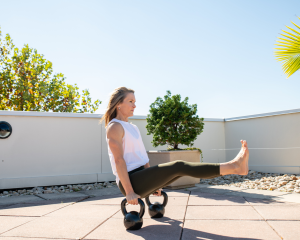I’ve spoken to you about how health and fitness can be measured relative to lifespan, the importance of exercise, and the benefits of making it a regular part of your daily life. Now it’s time to talk about the how. How do you make an exercise habit a priority when you’re busing managing your family, trying to be successful in your career, volunteering in the community, and all sorts of other priorities that seem to take precedence over staying in shape?
The answer is simple, really…make exercise a habit. I’m guessing your response to that last statement goes something like, “Wait a minute…developing a habit (or at least a good habit) isn’t simple.”
Well, you’re right. Developing a new habit may not be easy. But I can promise you this: it is absolutely worth every bit of effort it takes. Not only will your new, healthy habit help you, but it’s very likely it will rub off on those close to you.
Have I reeled you back in? Good.
When it comes to forming an exercise habit, fitness experts and coaches often refer to what is called the “transtheoretical model for change.” This model posits that health behavior change involves progress through six stages of change:
- Pre-contemplation You don’t exercise and you have no plans to start anytime soon.
- Contemplation You’re thinking about starting.
- Preparation You’ve made plans to start exercising in the next 30 days.
- Action You’ve started exercising, but have been at it fewer than six months.
- Maintenance You’ve been exercising for more than six months, and it’s become part of your daily routine.
- Termination You’re completely committed to your exercise routine and have no desire to return to your unhealthy behaviors and you’re sure you will not fall back in to old habits.
Now you know the stages of changing a behavior, the big question is how do you do it?
If you’re in the contemplation, preparation, or even the action stages, you can start creating a new habit by making small and what sometimes may seem insignificant choices over and over again until they become habits. Here are five proven habits that will help you adhere to a regular workout routine:
- Set goals You’re more likely to be successful at anything if you have goals. In terms of exercise, you’re more likely to be successful if you focus on intrinsic, rather than extrinsic, goals. This means that you’re more likely to continue with an exercise plan when you’re focused on internal goals, like exercise enjoyment or an increase in energy, rather than external goals, such as how you look or validation from others.
- Reward yourself Whatever it is that keeps you motivated, make a habit out of celebrating small triumphs; it can keep your momentum going.
- Mix up your activities Research has shown that variety in an exercise routine can increase adherence to regular physical activity. By making a habit of switching things from one day to the next, you’re more likely to stick with a program over time.
- Track your progress Something as simple as a Fitbit or any other activity tracker can be enough to keep you moving.
- Recruit friends and family Social support can play a major role in predicting your success in an exercise program. In fact, it can be among the most important factors in determining whether or not you stick with physical activity.
Exercising with one to two others will lead you to your fitness goals.
If you’ve read my previous two articles you know where I’m going to point you to start on your journey to better health – small group training classes at Fitness on the Run. Just look at some of the benefits of small group training and how they compare to what it takes to make exercise a daily habit:
- Personal attention With small group class, trainers can focus more attention on you – both in and out of class. Need help setting a goal? A trainer in a small group class is more apt to listen and help.
- Moral support Showing up to work is always easier if you know you have great co-workers. Working out in a small group can be the same way – you’ll get to know your classmates and you’ll likely become part of a community.
- Adherence If you know you’re only one of four people in a class, you’re more likely not let your friends and trainer down by skipping classes.
- Variety In small group training, classes will evolve as you and your classmates evolve.
- More fun The right exercise program done with friends can be fun – even at 5 or 6am!
Whether it’s personal training, our group classes (no more than 8), or our small group classes (no more than 4). We have a thoughtful programs of strength training, cardiovascular work and lots of FUN in between.



